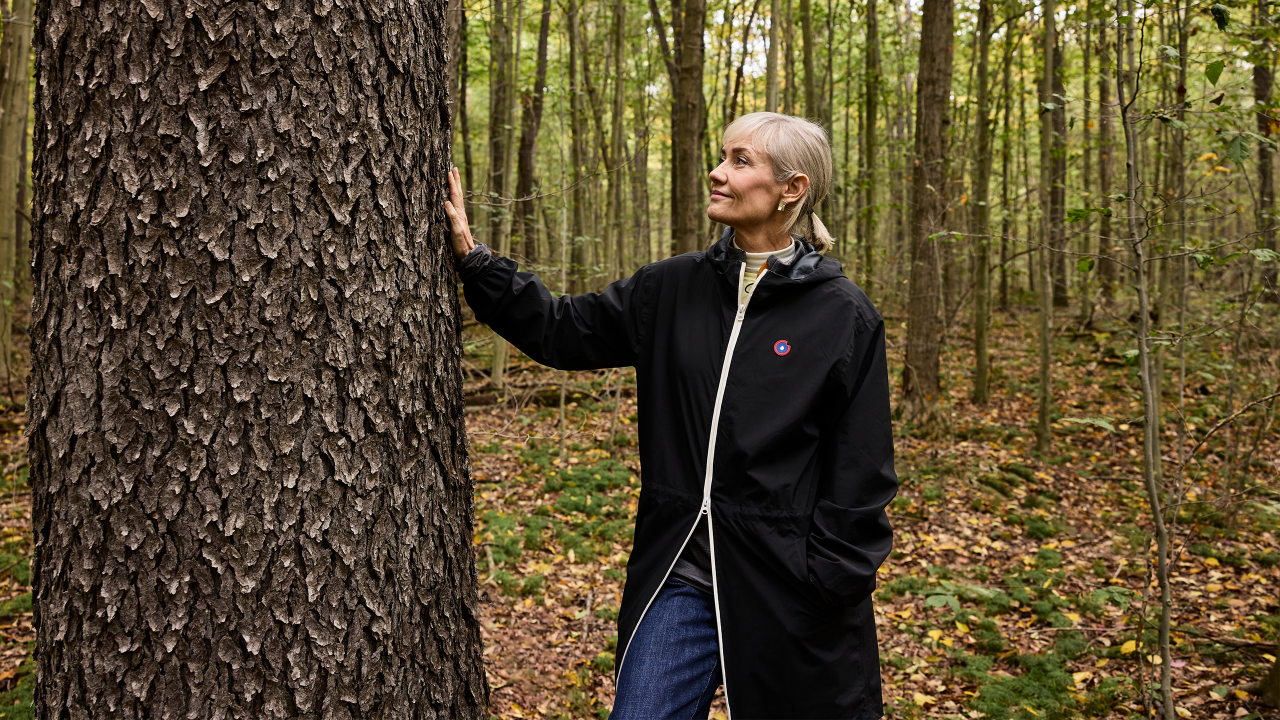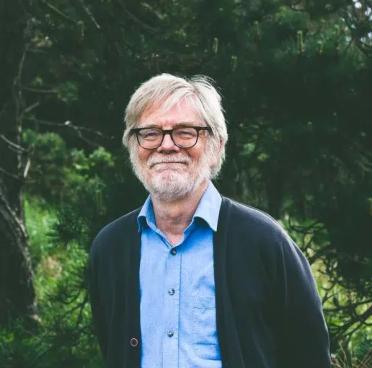
Stewards of The Forest: Alison's cherry pick
Stewards of The Forest: Stories of the people behind the diverse naturally regenerated hardwood forests of the eastern United States
Alison's cherry pick
“I am in awe,” says Alison Brooks. “It’s just incredible to see so many cherry trees in one place.” Alison is a leading British architect on a mission in the Appalachian Mountains to discover the source of her favourite wood, the one she puts in almost all her buildings. She is in the Allegheny National Forest in western Pennsylvania, marvelling at a natural cathedral of American black cherry trees. “They are so tall and straight, with this beautiful black bark. This place practically looks like architecture,” she says.
Canadian by birth, Alison has been a devoted fan of American black cherry wood since childhood, when her mother collected antique Canadian furniture bearing its rich, dark grain. As an award-winning architect, she says that “celebrating cherry has become a kind of life project.” Her pilgrimage has taken her to a region known as the black cherry capital of the world “to see and understand the life cycle of the tree, where it originates, and what makes its colour and grain so beautiful.”
Her first impressions in the forest are of surprise. “I’ve worked with this species for 25 years, but until now, I’ve never seen it in its forest setting,” she says. “In Britain, I am used to thinking of cherry trees as low, rounded and shrub-like, sitting in orchards with fruit dangling from their branches. But these are so different: great tall hardwoods dominating natural forest ecosystems. I can see now why their timber is so beautiful.”
Beauty matters to Alison. “What I love about cherry is its combination of strength and lightness,” she says. “It has a very beautiful grain, dense and with a surface consistency that is very calming.”
Her architectural designs have been described as “a late flowering of the most elegant and sensuous modernism.” For her, that sensuousness is about natural forms. “I think the whole idea of beauty is very much tied to natural materials, natural patterns and natural processes,” she says.
Alison is meeting up with research forester Susan Stout, who has spent a long career studying the regrowth of hardwood trees across western Pennsylvania. They were almost entirely wiped out by rampant clear-felling in the 19th century, but have since shown a remarkable ability to come back through natural regeneration. A vast new forest has emerged amid the stumps of the old.
A key question for Susan has been why there is so much more cherry today than there was in the old forests. The tree’s success, she has established, is in large part due to past ecological disasters.
First, the clear-felling of the old forest, with its huge stands of hemlock, maple and beech, left the once-shaded forest floor drenched in sunlight. That stimulated the regrowth of many different seeds left behind on the forest floor. But cherry, which hates shade more than most, prospered the best.
Then came air pollution, blown on the winds from industrial cities to the west, such as Detroit, Chicago and Cleveland. The nitrogen in the acid fallout was too much for many trees, but fertilised the growth of cherry. During the 20th century, cherry trees went from being 1% of the old forest to 23% of the new one.
Their heyday may now be gone, however. With less sunlight penetrating the canopy of the restored forest, and the decline of smogs after clean-air legislation in 1991, cherry has lost its competitive advantage.
“In future, the species mix in the forest will be very different,” says Susan, who became an emeritus scientist at the U.S. Forest Service after retiring in 2018. “But don’t worry, Alison, cherry will still be here, producing trees that can go into your buildings.”
Alison looks relieved. For she loves forests as well as the wood it provides for her business. Growing up in Canada in the 1960s, she spent her summers at her family’s log cabin on one of thousands of tiny islands in Georgian Bay, an offshoot of Lake Huron, one of the Great Lakes. She still goes back there each year.
“We lived off-grid and depended for pretty much everything on the trees there: for fuel, for building materials and, of course, for the wonderful sense of wilderness,” she remembers. “It was so elemental. I want to bring some of that to my architecture.”
And so she has. At the start of her career, Alison incorporated cherry into a house she designed on Hampstead Heath in North London. It won a top British architecture award and “set my practice on a path,” she says. Most recently, Alison has featured cherry extensively in a new building she designed for an ancient Oxford college, and in her own arts-and-crafts house in West London.
There, the climb to her bedroom at the top of the house passes through a suspended staircase constructed entirely from American cherry. She finds joy in it every day. “There is just something deeply satisfying about moving through a space that is made from a single material,” she says. Meanwhile, an extension she is building at the back of the house has, as its centrepiece, a circular skylight from which 26 curved cherry beams radiate.
Back in the forest where that cherry came from, Alison is keen to understand the care taken to maintain its ecology – to confirm assurances from her suppliers that she is not profiting from unsustainable plunder.
Susan says ensuring that sustainability has been her life’s work. The aim of the science – carried out at an experimental forest near the Allegheny town of Kane – is to track trends and ensure the forest is tended so that every species leaves seeds able to replace trees cut by humans or downed by wind storms. “Take a look at the forest floor,” she says. “You can see the next generation starting to grow. There is another whole diverse forest happening down there in miniature.”
Susan may be a scientist, but she is also a passionate tree-lover. “I feel a really deep connection with these woods,” she tells Alison. “Like you, I grew up amid trees. I turned to forestry because I wanted to sustain this balance between a beautiful natural environment and meeting human needs.”
She is doing that at scale. At half a million acres, the Allegheny National Forest is the largest publicly owned forest in the state. It has been managed for long-term restoration ever since it was established in 1923, out of the carnage of the clear-felling era.
On their final stop, the two women meet Mike Williams, the forest’s timber contracting officer. Mike’s job is to decide who can cut what trees. That makes him the chief arbiter for reconciling the needs of both the forest and the people who depend on it. “We are the stewards of one of America’s great forests. It’s a huge responsibility,” he says.
“The money we make on the timber sales goes right back into the community. It contributes to our schools and municipalities, and it employs my friends and neighbours,” he says. “But the forest is also a source of food for the community, as well as a playground for visitors, and a place that sustains all our spirits.”
His voice breaks with emotion. We stop recording for a moment before he resumes. “Sorry, I get a little emotional,” he says. “My job is important because I’m trying to make sure that this place is here for my kids, and my grandkids, that everyone can come here and enjoy the forest and can know it is in good hands, now and in the future.”
And, along the way, of course, to ensure that the cherry is still there for Alison to bring joy to people across the Atlantic who may never see the forest that it came from.
